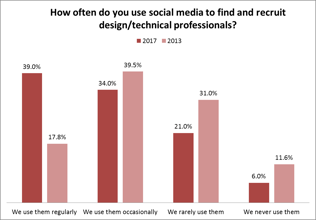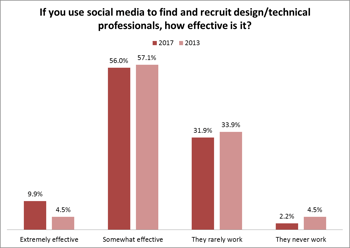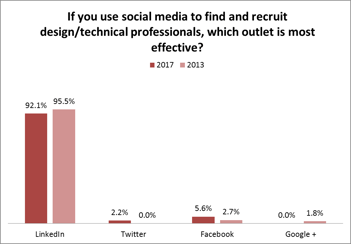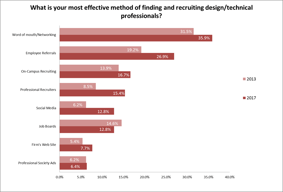Recruiting top talent remains a major challenge for architecture and engineering firms. Moreover, attracting and keeping the best architects and engineers is crucial to firm success. Offering a competitive compensation package is certainly a crucial component of recruiting, but the first step is to identify the most effective approach to finding top talent. With so many recruiting outlets available, it is important the identify the best, and not waste time and money on those that are just not that useful.
In 2017, PSMJ's A/E Recruiting Study: How Today’s Most Successful Firms Find and Recruit Talentreported on what we learned about how firms find and recruit talent and how effective each outlet is. This year, we are conducting a 2019 A/E Recruiting Study, with the aim of determining if and how recruiting trends have changed compared to those reported in 2017.
In the 2017 study, we asked a range of questions relating to how firms most frequently find and recruit talent, and then overlayed that data against what recruiting practices respondents believe are the most effective. We compared this year’s results with those from a similar recruiting study done in 2013.
 For instance, regular use of social media to find and recruit design/technical professionals had increased dramatically. Since 2013, regular use of LinkedIn, Twitter, etc. had more than doubled, increasing from nearly 18 percent to 39 percent. Not surprisingly, only six percent of firms reported that they never use social media for their recruitment efforts.
For instance, regular use of social media to find and recruit design/technical professionals had increased dramatically. Since 2013, regular use of LinkedIn, Twitter, etc. had more than doubled, increasing from nearly 18 percent to 39 percent. Not surprisingly, only six percent of firms reported that they never use social media for their recruitment efforts.
Meanwhile, we found little change over the past four years in how firms perceived the effectiveness of social media to find and recruit talent. Today and in 2013, more than half of participants said social media is somewhat effective, while close to one-third found that it rarely works. Meanwhile, few firms perceived social media to be either extremely effective or that it never works. Then and now, LinkedIn was seen as the most effective (see charts below).



Moreover, in both 2017 (32 percent) and 2013 (36 percent), the majority of participants reported word of mouth/networking as their most effective recruiting method. This was followed by employee referrals in both 2017 (19 percent) and 2013 (27 percent). Interestingly, percentages for all the recruiting methods increased from 2013 to 2017, with the exception of job boards (see chart right).
How will these and other key recruiting trends change in 2019?
PSMJ Resources is conducting a research project to determine how leading A/E find and recruit design/technical professionals today.
The result will be a comprehensive analysis of recruiting best practices that will be presented at RecruitMAX 2019to be held on July 23-24, 2019 in Seattle. This conference is specifically designed to address issues faced by senior HR leaders and other key executives in the A/E/C industry.
The survey should take about 15 minutes to complete. To thank you for your participation, we will provide a complimentary copy of the executive summary report to all participants.



